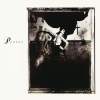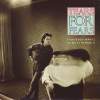
For the most part, the drums here are extraordinarily dull-sounding for a pop record, but the reason they don’t seem that dull is because the snare has a tiny 4ms-long slice of dense high-frequency energy right on its leading edge. Compare, for instance, the enormous perceptual difference it makes if I use region-specific 2kHz low-pass filtering just on those little 4ms snare-drum slices. Unprocessed: play_arrow | get_app With region LPFs: play_arrow | get_app The advantage of creating only a scanty illusion of a full-range drumkit spectrum like this is that it keeps the upper spectrum of the mix much clearer for other elements of the production such as the 80s-throwback synths and the vocal details and effects.
Speaking of vocal effects, there are not only some lovely SFX spins (the Fairlight-esque pitch-modulated BVs at 0:33 and 1:31, for instance, or the trippy stereo delay tails after “clouds” at 1:51), but also a very effective moment where the effects saturation suddenly collapses into a much drier texture for the end of the word “you” at 2:45. What’s particularly interesting there, though, is that the vocal sound isn’t completely free of effects, because there’s still plenty of stereo widener, and that actually stands to reason. You see, the point of drying up the vocal sound like this is to thrust the singer right out front to grab your attention, and stereo width is one cue we use to gauge the proximity of a sound source – after all, things in the real world tend to sound narrower the further they are away from you. So it makes sense that you wouldn’t want to mute the stereo widening in this context, even though you’d want to mute the distancing effects such as reverb and delay.










